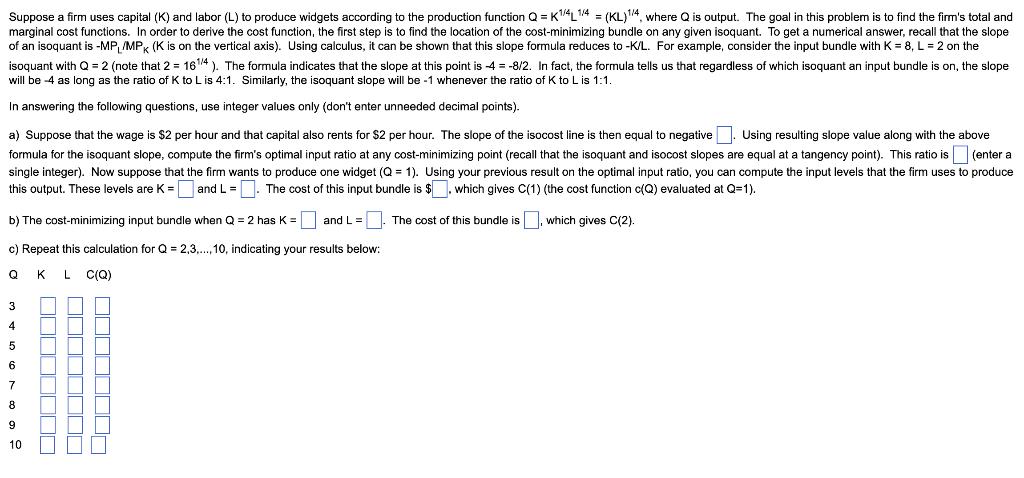Answered step by step
Verified Expert Solution
Question
1 Approved Answer
Suppose a firm uses capital (K) and labor (L) to produce widgets according to the production function Q=K1/4L1/4 = (KL)1/4, where Q is output.

Suppose a firm uses capital (K) and labor (L) to produce widgets according to the production function Q=K1/4L1/4 = (KL)1/4, where Q is output. The goal in this problem is to find the firm's total and marginal cost functions. In order to derive the cost function, the first step is to find the location of the cost-minimizing bundle on any given isoquant. To get a numerical answer, recall that the slope of an isoquant is -MP/MPK (K is on the vertical axis). Using calculus, it can be shown that this slope formula reduces to -K/L. For example, consider the input bundle with K = 8, L = 2 on the isoquant with Q = 2 (note that 2 = 161/4). The formula indicates that the slope at this point is -4 = -8/2. In fact, the formula tells us that regardless of which isoquant an input bundle is on, the slope will be -4 as long as the ratio of K to L is 4:1. Similarly, the isoquant slope will be -1 whenever the ratio of K to L is 1:1. In answering the following questions, use integer values only (don't enter unneeded decimal points). a) Suppose that the wage is $2 per hour and that capital also rents for $2 per hour. The slope of the isocost line is then equal to negative. Using resulting slope value along with the above formula for the isoquant slope, compute the firm's optimal input ratio at any cost-minimizing point (recall that the isoquant and isocost slopes are equal at a tangency point). This ratio is (enter a single integer). Now suppose that the firm wants to produce one widget (Q = 1). Using your previous result on the optimal input ratio, you can compute the input levels that the firm uses to produce this output. These levels are K = and L=. The cost of this input bundle is $. which gives C(1) (the cost function c(Q) evaluated at Q=1). b) The cost-minimizing input bundle when Q = 2 has K = and L=. The cost of this bundle is, which gives C(2). c) Repeat this calculation for Q = 2,3,..., 10, indicating your results below: Q K L C(Q) 3 4 5 6 7 8 9 10 DUOL T JUU
Step by Step Solution
★★★★★
3.34 Rating (163 Votes )
There are 3 Steps involved in it
Step: 1
A ANSWER The slope of isocost line221 Optimal input ratioKL221 So KL11 If KL then QKL14 or QL...
Get Instant Access to Expert-Tailored Solutions
See step-by-step solutions with expert insights and AI powered tools for academic success
Step: 2

Step: 3

Ace Your Homework with AI
Get the answers you need in no time with our AI-driven, step-by-step assistance
Get Started


